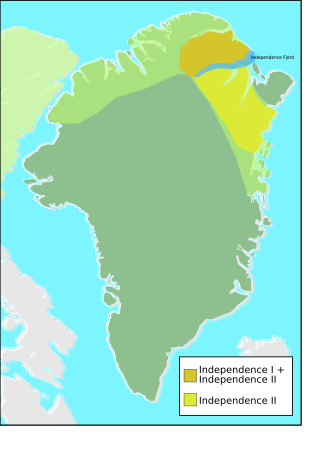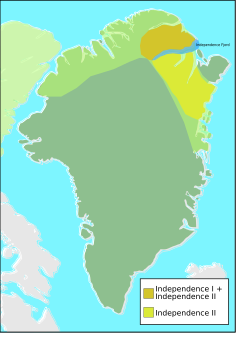
Greenland is a North American autonomous territory of the Kingdom of Denmark. It is the larger of two autonomous territories within the Kingdom, the other being the Faroe Islands; the citizens of both territories are full citizens of Denmark. As Greenland is one of the Overseas Countries and Territories of the European Union, citizens of Greenland are European Union citizens. The capital and largest city of Greenland is Nuuk. Greenland lies between the Arctic and Atlantic oceans, east of the Canadian Arctic Archipelago. It is the world's largest island, and is the location of the northernmost area of the world – Kaffeklubben Island off the northern coast is the world's northernmost undisputed point of land, and Cape Morris Jesup on the mainland was thought to be so until the 1960s.

The history of Greenland is a history of life under extreme Arctic conditions: currently, an ice sheet covers about eighty percent of the island, restricting human activity largely to the coasts.

Peary Land is a peninsula in northern Greenland, extending into the Arctic Ocean. It reaches from Victoria Fjord in the west to Independence Fjord in the south and southeast, and to the Arctic Ocean in the north, with Cape Morris Jesup, the northernmost point of Greenland's mainland, and Cape Bridgman in the northeast.

Sisimiut, formerly known as Holsteinsborg, is the capital and largest city of the Qeqqata municipality, the second-largest city in Greenland, and the largest Arctic city in North America. It is located in central-western Greenland, on the coast of Davis Strait, approximately 320 km (200 mi) north of Nuuk.

Independence I was a culture of Paleo-Eskimos who lived in northern Greenland and the Canadian Arctic between 2400 and 1900 BC. There has been much debate among scholars on when Independence I culture disappeared, and, therefore, there is a margin of uncertainty with the dates.

Greenland Medal for Meritorious Service, is awarded by the Greenland Home Rule government. It is the highest award based in Greenland. The medal was instituted on 1 May 1989 in connection with the ten-year anniversary of the Greenlandic home rule. The medal is awarded for meritorious service for Greenland in fields such as public service, business, art, or science. The medal is worn in a ribbon of the Greenlandic colours; red symbolising the sun and white symbolising the snow. The medal is awarded in two grades: gold and silver.
Brønlundhus, on some maps also Brønlundfjord, is a former research station and radio station located on the western shore of Jørgen Brønlund Fjord in southern Peary Land, in northern Greenland. It is named after Greenlandic Arctic researcher Jørgen Brønlund, or after the namesake fjord on which it is located. It is close to the mouth of Jørgen Brønlund Fjord where it opens into Independence Fjord.
Count Eigil Knuth was a Danish explorer, archaeologist, sculptor and writer. He is referred to as the Nestor of Danish polar explorers. His archaeological investigations were made in Peary Land and adjacent areas of High Arctic Greenland. Knuth was made a Knight of the Dannebrog.
The Pre-Dorset is a loosely defined term for a Paleo-Eskimo culture or group of cultures that existed in the Eastern Canadian Arctic from c. 3200 to 850 cal BC, and preceded the Dorset culture.
Deltaterrasserne is a pre-Inuit occupation archaeological site located near the head of Jørgen Brønlund Fjord on the Peary Land peninsula in northern Greenland. It is one of the largest archaeological sites in Peary Land, and was discovered in September 1948 by the Danish explorer and archaeologist Eigil Knuth during the second summer of the Danish Pearyland Expedition. Occupied during the period of 2,050–1,750 BC, the site contains features of Independence I and Independence II cultures.

Skjoldungen is a large uninhabited island in the King Frederick VI Coast, southeastern Greenland. Administratively it is part of the Sermersooq municipality. The weather of the island is characterized by tundra climate.

Cape Bridgman is a headland in the Wandel Sea, Arctic Ocean, northeast Greenland.

Sands Fjord is a fjord in Peary Land, northern Greenland. To the north, the fjord opens into the Lincoln Sea of the Arctic Ocean. Administratively, it belongs to the Northeast Greenland National Park.

Frigg Fjord is a fjord in Peary Land, far northern Greenland.

Johannes V. Jensen Land is an area in Peary Land, Northern Greenland. Administratively it lies in the Northeast Greenland National Park zone. The area is remote and currently uninhabited.

Cape Harald Moltke is a headland in Peary Land, North Greenland. Administratively it is part of the Northeast Greenland National Park.

Wyckoff Land is an area or peninsula in Peary Land, Northern Greenland.
Port Refuge is located off the south coast of Grinnell Peninsula in a small bay on the south coast of Devon Island in Nunavut, Canada. The site received its current name by Sir Edward Belcher when he sought refuge there in 1852-1853 from moving ice during his voyage in search of the missing Franklin Expedition.

Herluf Trolle Land is an area in Peary Land, North Greenland. Administratively it is part of the Northeast Greenland National Park.










